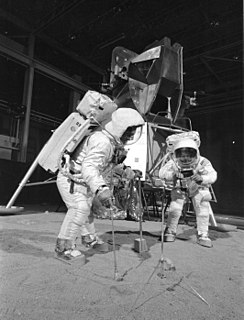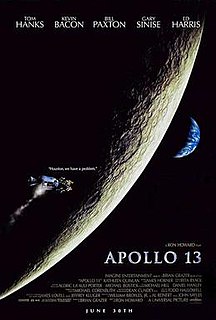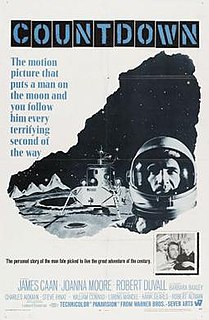
The Apollo program, also known as Project Apollo, was the third United States human spaceflight program carried out by the National Aeronautics and Space Administration (NASA), which succeeded in landing the first humans on the Moon from 1969 to 1972. First conceived during Dwight D. Eisenhower's administration as a three-man spacecraft to follow the one-man Project Mercury which put the first Americans in space, Apollo was later dedicated to President John F. Kennedy's national goal of "landing a man on the Moon and returning him safely to the Earth" by the end of the 1960s, which he proposed in an address to Congress on May 25, 1961. It was the third US human spaceflight program to fly, preceded by the two-man Project Gemini conceived in 1961 to extend spaceflight capability in support of Apollo.

Apollo 13 was the seventh manned mission in the Apollo space program and the third intended to land on the Moon. The craft was launched on April 11, 1970 from the Kennedy Space Center, Florida, but the lunar landing was aborted after an oxygen tank exploded two days later, crippling the service module (SM) upon which the command module (CM) had depended. Despite great hardship caused by limited power, loss of cabin heat, shortage of potable water, and the critical need to make makeshift repairs to the carbon dioxide removal system, the crew returned safely to Earth on April 17, 1970, six days after launch.

Apollo 10 was the fourth manned mission in the United States Apollo space program, and the second to orbit the Moon. Launched on May 18, 1969, it was the F mission: a "dress rehearsal" for the first Moon landing, testing all of the components and procedures, just short of actually landing. The Apollo Lunar Module (LM) was flown to a descent orbit within 8.4 nautical miles (15.6 km) of the lunar surface, at the point where powered descent for landing would normally begin. Its success enabled the first landing to be attempted on the Apollo 11 mission two months later.

Apollo 17 was the final mission of NASA's Apollo program and the last mission as of 2019 in which humans have travelled to and walked on the Moon. Launched at 12:33 a.m. Eastern Standard Time (EST) on December 7, 1972, with a crew made up of Commander Eugene Cernan, Command Module Pilot Ronald Evans, and Lunar Module Pilot Harrison Schmitt, it was the last use of Apollo hardware for its original purpose; after Apollo 17, extra Apollo spacecraft were used in the Skylab and Apollo–Soyuz programs.

Moon landing conspiracy theories claim that some or all elements of the Apollo program and the associated Moon landings were hoaxes staged by NASA, possibly with the aid of other organizations. The most notable claim is that the six manned landings (1969–72) were faked and that 12 Apollo astronauts did not actually walk on the Moon. Various groups and individuals have made claims since the mid-1970s that NASA and others knowingly misled the public into believing the landings happened, by manufacturing, tampering with, or destroying evidence including photos, telemetry tapes, radio and TV transmissions, Moon rock samples, and even killing some key witnesses.

Apollo 13 is a 1995 American space docudrama film directed by Ron Howard and starring Tom Hanks, Kevin Bacon, Bill Paxton, Gary Sinise, and Ed Harris. The screenplay by William Broyles Jr., and Al Reinert dramatizes the aborted 1970 Apollo 13 lunar mission and is an adaptation of the book Lost Moon: The Perilous Voyage of Apollo 13 by astronaut Jim Lovell and Jeffrey Kluger. The film depicts astronauts Lovell, Jack Swigert, and Fred Haise aboard Apollo 13 for America's third Moon landing mission. En route, an on-board explosion deprives their spacecraft of most of its oxygen supply and electric power, forcing NASA's flight controllers to abort the Moon landing, and turning the mission into a struggle to get the three men home safely.

From the Earth to the Moon is an 1865 novel by Jules Verne. It tells the story of the Baltimore Gun Club, a post-American Civil War society of weapons enthusiasts, and their attempts to build an enormous Columbiad space gun and launch three people—the Gun Club's president, his Philadelphian armor-making rival, and a French poet—in a projectile with the goal of a Moon landing.

Eugene Andrew Cernan was an American astronaut, naval aviator, electrical engineer, aeronautical engineer, and fighter pilot. During the Apollo 17 mission, Cernan became the eleventh person to walk on the Moon. Since he re-entered the Apollo Lunar Module after Harrison Schmitt on their third and final lunar excursion, he is the last person to have walked on the Moon.

Eugene Francis "Gene" Kranz is an American aerospace engineer, retired fighter pilot and a retired NASA Flight Director and manager. Kranz served as the second Chief Flight Director, succeeding the NASA founding Flight Director Chris Kraft, during the Gemini and Apollo programs. He is best known for his role in directing the successful Mission Control team efforts to save the crew of Apollo 13, which later became the subject story of a major motion picture of the same name, in which he was portrayed by actor Ed Harris, and serving as flight director during the first lunar landing of Apollo 11. He was in the Flight Control Room during the launching of Space Shuttle Challenger. He is also noted for his trademark close-cut flattop hairstyle, and the wearing of dapper "mission" vests (waistcoats), of different styles and materials made by his wife, Marta Kranz, during missions for which he acted as Flight Director.

From the Earth to the Moon is a 12-part 1998 HBO television miniseries co-produced by Ron Howard, Brian Grazer, Tom Hanks, and Michael Bostick, telling the story of the landmark Apollo program during the 1960s and early 1970s in docudrama format. Largely based on Andrew Chaikin's book, A Man on the Moon, the series is known for its accurate telling of the story of Apollo and the outstanding special effects under visual director Ernest D. Farino.

A Moon landing is the arrival of a spacecraft on the surface of the Moon. This includes both manned and unmanned (robotic) missions. The first human-made object to reach the surface of the Moon was the Soviet Union's Luna 2 mission, on 13 September 1959.

Space is a novel by James A. Michener published in 1982. It is a fictionalized history of the United States space program, with a particular emphasis on manned spaceflight.

For All Mankind is a 1989 documentary film drawn from original footage of NASA's Apollo program which successfully landed the first humans on the Moon from 1969 to 1972. It was directed by Al Reinert with music by Brian Eno. The film concentrates on the beauty of the Earth as seen from space with the experiences of Apollo crew members and mission control staff played over original mission footage.

NASA's Astronaut Group 5 was a group of nineteen astronauts selected by NASA in April 1966. Of the six Lunar Module Pilots that walked on the Moon, three came from Group 5. The group as a whole is roughly split between the half who flew to the Moon and the other half who flew Skylab and Shuttle, providing the core of Shuttle Commanders early in that program. This group is also distinctive in being the only time when NASA hired a person into the astronaut corps who had already earned astronaut wings, X-15 pilot Joe Engle. John Young labelled the group the "Original Nineteen" in parody of the original seven Mercury astronauts.

A Funny Thing Happened on the Way to the Moon is a 2001 film written, produced and directed by Nashville-based filmmaker Bart Sibrel. Sibrel is a critic of the Apollo program and proponent of the conspiracy theory that the six Apollo Moon landing missions between 1969 and 1972 were elaborate hoaxes perpetrated by the United States government, including NASA.

Countdown is a 1968 science fiction film directed by Robert Altman, based on the novel The Pilgrim Project by Hank Searls. It stars James Caan and Robert Duvall as astronauts vying to be the first American to walk on the Moon as part of a crash program to beat the Soviet Union.

The Right Stuff is a 1979 book by Tom Wolfe about the pilots engaged in U.S. postwar research with experimental rocket-powered, high-speed aircraft as well as documenting the stories of the first Project Mercury astronauts selected for the NASA space program. The Right Stuff is based on extensive research by Wolfe, who interviewed test pilots, the astronauts and their wives, among others. The story contrasts the "Mercury Seven" and their families with test pilots such as Chuck Yeager, who was considered by many contemporaries as the best of them all, but who was never selected as an astronaut.
Moon Machines in the United States and United Kingdom is a Science Channel HD documentary miniseries consisting of six episodes documenting the engineering challenges of the Apollo program to land men on the Moon. It covers everything from the iconic Saturn V to the Command Module, the Lunar Module, the Space Suits, the Guidance and Control Computer, and the Lunar Rover. It was created by the team that made In the Shadow of the Moon in association with NASA to commemorate the agency's fiftieth anniversary in 2008. It first aired in June 2008 and was released on DVD a year later in June 2009.






















